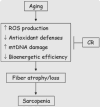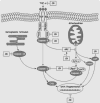Sarcopenia of aging: underlying cellular mechanisms and protection by calorie restriction
- PMID: 19319843
- PMCID: PMC5992495
- DOI: 10.1002/biof.5
Sarcopenia of aging: underlying cellular mechanisms and protection by calorie restriction
Abstract
Sarcopenia, the loss of muscle mass and function, is a common feature of aging and impacts on individual health and quality of life. Several cellular mechanisms have been involved in the pathogenesis of this syndrome, including mitochondrial dysfunction, altered apoptotic and autophagic signaling, and, more recently, trace metal dyshomeostasis. Calorie restriction (CR) without malnutrition has been shown to ameliorate the age-related loss of muscle mass in a variety a species. Mechanisms of protection span from preservation of mitochondrial functional and structural integrity to mitochondrial biogenesis, reduction of oxidative stress, and favorable modulation of apoptotic and autophagic signaling pathways. Importantly, preliminary evidence indicates that moderate CR may promote muscle mitochondrial biogenesis in middle-aged human subjects. Further research is warranted to investigate whether CR may represent a safe and efficient strategy to delay the onset and mitigate the progression of sarcopenia in older adults.
(c) 2009 International Union of Biochemistry and Molecular Biology, Inc.
Figures



References
-
- Fisher AL. Of worms and women: sarcopenia and its role in disability and mortality. J Am Geriatr Soc. 2004;52:1185–1190. - PubMed
-
- Szulc P, Beck TJ, Marchand F, Delmas PD. Low skeletal muscle mass is associated with poor structural parameters of bone and impaired balance in elderly men—the MINOS study. J Bone Miner Res. 2005;20:721–729. - PubMed
-
- Rantanen T, Guralnik JM, Foley D, Masaki K, Leveille S, Curb JD, White L. Midlife hand grip strength as a predictor of old age disability. JAMA. 1999;281:558–560. - PubMed
-
- Metter EJ, Talbot LA, Schrager M, Conwit R. Skeletal muscle strength as a predictor of all-cause mortality in healthy men. J Gerontol A Biol Sci Med Sci. 2002;57:B359–B365. - PubMed
-
- Iannuzzi-Sucich M, Prestwood KM, Kenny AM. Prevalence of sarcopenia and predictors of skeletal muscle mass in healthy, older men and women. J Gerontol A Biol Sci Med Sci. 2002;57:M772–M777. - PubMed
Publication types
MeSH terms
Grants and funding
LinkOut - more resources
Full Text Sources
Medical

